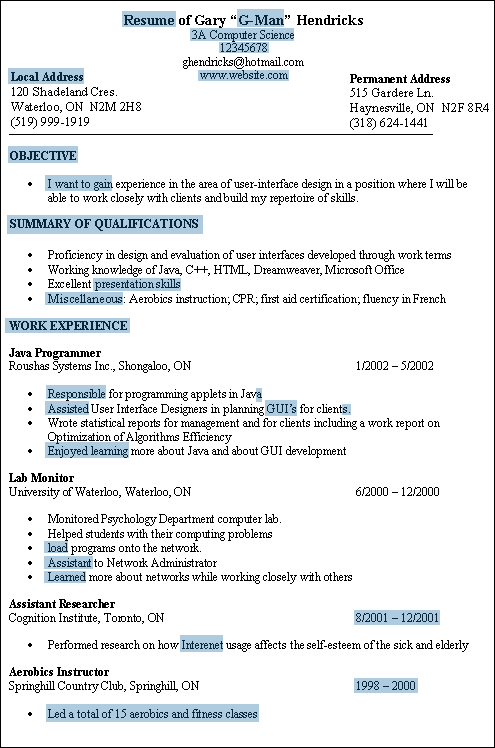|
Never use the word "resume" on the top of your resume. |
|
Never list a nickname in the personal information section - especially an unprofessional one like this. |
|
Co-op students should include academic level, plan name, and University of Waterloo ID #. |
|
If you include your web page, make sure it is for a professional, business-like site. Likewise, make sure that the name of the site - and everything else listed on your resume - is professional. |
|
This is an appropriate way to list multiple addresses. Decide what headings you will use if you need to state two addresses (e.g., one "local" or "present" and the other "home" or "permanent"). If leaving an address while your resume is in circulation, note when (e.g., until August 20, 2003). |
|
This section of a resume allows employers to know the kind of position you are seeking. It is optional for those writing a resume for co-op, summer or part-time employment (although a growing number of employers are indicating a desire to see this for all types of employment). |
|
This is a weak objective statement. You should state your goal or objective in terms of what you can do for an employer, not what you want an employer to do for you. Also, you should phrase the statement around the job you want now, by job title or area. Lastly, make sure there are no spelling errors anywhere on the resume, as here with "repertoir." |
|
This section will provide a concise overview of your qualifications as they relate to your objective. This is where you want the employer to become interested in the competitive advantage you bring. Include four to six points outlining your most relevant strengths for the type of work you are seeking. Describe your competitive advantage - the value you offer. |
|
A skills summary should include skills which will be demonstrated later in the resume. Here, presentation skills is listed; however, no proof of them is given later in the resume. |
|
This line contains punctuation and grammatical errors. Should read: Miscellaneous: Aerobics instruction; CPR; first aid certification; fluency in French. The bigger question though is why it is included at all. Only include information that is related to the objective. If it is relevant and important, don't label it miscellaneous. |
|
There are three different types of resumes: chronological, modified chronological, and functional. This is a chronological resume; so jobs should be organized in reverse chronological order, stating the role title (create an accurate one if you had none), the name of the company / organization, the location, and the beginning and ending dates for each work experience. Be consistent in use of dates. For jobs held for one year or less, we recommend including the month (in words) and year (e.g. January 2002). It is best to spell out month name or to use a consistent abbreviation. |
|
Avoid expressions such as "responsible for" or "duties included" as your accomplishments may not be understood. |
|
Avoid verbs such as: "assisted", "helped", "aided", "participated" or "involved" as they do not say precisely what you did; and the employer will not know what your contribution was. Instead, begin with strong verbs (e.g., wrote, presented, advised, etc.) and, to eliminate any misconception that you might be responsible for the total project, end with "in conjunction with", "in collaboration with", "as a member of [design] team", etc. |
|
Be sure to spell out acronyms or industry-specific jargon; GUI should be "graphical user interface". |
|
Use consistent punctuation. This resume sometimes uses periods and sometimes does not. It is not necessary to have periods at the end of statements as they are not full sentences. Be careful to avoid such carelessness. |
|
This is an unnecessary statement. Start each entry with an action verb and resist the temptation to "sum up" the job by describing what you learned or enjoyed. Instead, list only the job responsibilities and save the discussion of what you learned and/or enjoyed about previous jobs for your cover letter. One exception: if you learned something on the job (e.g., new piece of software) but did not get a chance to use it on the job, you could include it as a "learned" statement. |
|
Use consistent capitalization methods. Also, write in the past tense for former positions. |
|
Begin each entry with an action verb. In this case, "Assistant to Network Administrator" could be replaced with "Troubleshot problems with the departmental network, in conjunction with Psychology Department Network Administrator." |
|
Misspelled word. Have someone proofread your resume to find spelling and grammatical errors. Avoid using only one bullet of information. |
|
This is a bad page break. Carefully ensure that a work or education experience is not being divided between the first and second pages of your resume. |
|
These job experiences should be in reverse chronological order so this work experience is out of order. |
|
If a job experience lasted over one year, it is not necessary to list the months you began and ended. Therefore, this example is perfectly acceptable. |
|
Click here to go to page 2 of this resume. |
